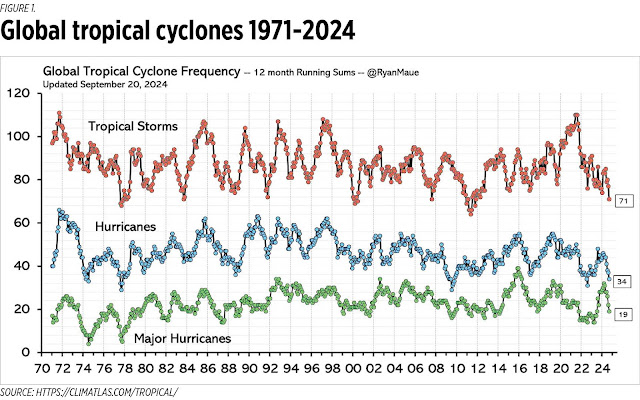Coal’s economic contribution, the new ERC Chair
September 26, 2024 | 12:02 am
My Cup Of Liberty
By Bienvenido S. Oplas, Jr.
A quick update on the number of global tropical storms was made by Dr. Ryan Maue. One narrative about “man-made” climate change is that there are now more frequent storms and stronger storms than in the past. The data says there is no truth to the former claim (see Figure 1).
The claim that storms are getting stronger is also not true. The accumulated cyclone energy (ACE) just shows the natural cycle of high-low ACE, like the period 2021-2024 has low ACE.
The pattern of ice growth and melting in both the Arctic and Antarctica remains the same. Data from 1978-2024 can be viewed here, https://wattsupwiththat.com/reference-pages/sea-ice-page/.
There is no climate crisis to justify the continued demonization of coal, oil, gas, and nuclear, and the continued push for intermittent solar and wind power. We need the “business as usual” power sources to sustain the growth path of developing countries like the Philippines.
Developed Western countries like the US, the UK, Germany, and Spain have greatly moved away from coal power. In the process, their average economic growth has been declining while their average inflation rate has been rising. The opposite trend is shown in coal-heavy Asian nations like China, India, Indonesia, and Vietnam (see Figure 2).
Related to this, the Coaltrans Asia 2024 forum was held in Bali, Indonesia on Sept. 10. According to a press release, Aboitiz Power Corp. Chief Operating Officer for Thermal Operated Assets Ronaldo Ramos was one of the speakers, and he said that “We need reliable and reasonably priced baseload power to address the inherent intermittency of renewable energy and the geographical challenges of injecting these intermittent capacities to our present grid.”
This was reported also in BusinessWorld, “AboitizPower: Renewables need baseload for reliability” (Sept. 25). Mr. Ramos’ statement is corroborated by the numbers. Developing countries cannot just dump cheap and stable energy and expect growth to remain high. It did not happen and will not happen.
A coal plant that is visible from the house of my parents-in-law in Lapaz, Iloilo City, is that of the Panay Energy Development Corp. (unit 1 is 167 MW, unit 2 is 150 MW), owned by Meralco PowerGen Corp. Day or night, I did not see the black smoke that we often see in photos and campaign materials of the climate activists. Some BBQ stands nearby produce more visible smoke than that coal plant.
Panay island is composed of four provinces (Iloilo, Capiz, Aklan, Antique) and is growing fast — they need adequate, reliable, and cost-efficient energy. Meralco spokesman Joe Zaldariaga went there this week and he said that “The power plant is beside a residential area and the lush greeneries and mangrove areas nearby complement the sustainability in the place and is proof that high performance clean coal stations can co-exist with urban residents.”
THE NEW ERC CHAIRPERSON
The newly appointed OIC of the Energy Regulatory Commission (ERC), former Justice Undersecretary Jesse T. Andres, is my batchmate from UP School of Economics (1984). I learned about this when he joined our batch’s Viber group. I have communicated with him some of my observations about the country’s energy regulation system.
I think these issues need to be addressed and prioritized by the ERC.
1. Power Supply Agreement, (PSA) and Ancillary Services Procurement Agreement, (ASPA) should get the ERC nod if these have gone through the mandatory competitive selection process (CSP) that ERC itself oversees.
2. Barriers to the entry of new generation companies (gencos) should be reduced. ERC processes in Energy Virtual One-Stop Shop (EVOSS) system should be included and timelines should be observed and met.
3. The recent ERC limitations on retail electricity supply (RES) of up to a 50% limit on affiliate gencos should be reviewed if not removed.
4. The price control at the Wholesale Electricity Spot Market (WESM) via secondary price cap (only P6.25/kWh, which was imposed by the ERC around 2014, a decade ago) should be removed. If the price is capped, the supply curve shifts to the left while the demand curve remains the same. This largely explains the frequent yellow-red alerts that we experience yearly. Peaking plants to supply peak demand are not there as they are discouraged by price controls.
5. The performance-based regulation process for distribution utilities and electric cooperatives should proceed for their upcoming regulatory periods.
6. The “cost-based evaluation” for genco applications should be removed because the generation sector is supposed to be competitive. This should force the gencos to make their operations more efficient to make them profitable. High efficiency means a high probability of winning CSPs with low prices for the consumers.
For regulated entities (distribution utilities and transmission), performance-based regulation (PBR) was introduced in the early 2000s as an alternative design to regulation. PBR will push the monopoly to act as if it is under a competitive regime, increasing its efficiencies while meeting its performance targets thereby substantially reducing the “deadweight loss” to society from a monopolistic market. PBR uses forecasts instead of historic values. The monopoly is allowed to keep efficiency gains and the focus should be on the performance of the utility. PBR is an economic concept but recently it has become an accounting exercise when it should be an economics exercise.
Regulators’ biggest service to the public is to expand consumer choice. Let them choose and decide whether to consume 1,000 kWh, or 500 kWh, or just 200 kWh per month, provided that the electricity is there when they need it. Their choice should not be limited to using candles or kerosene torches or diesel gensets due to frequent blackouts.


No comments:
Post a Comment